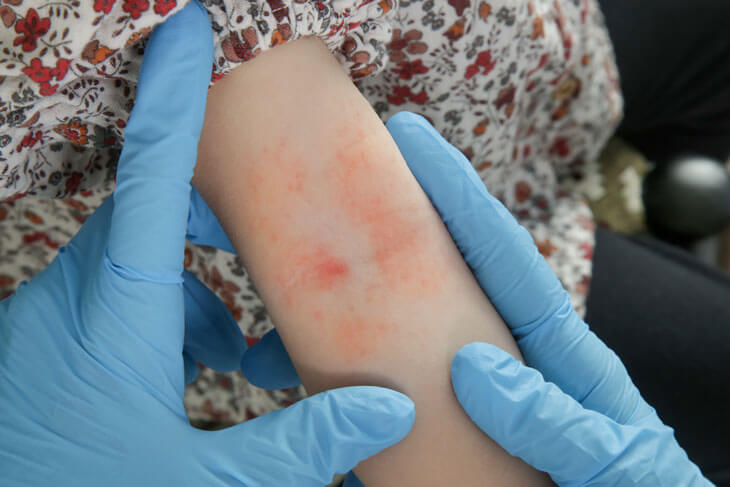Neurodermatitis
What is neurodermatitis and where does it come from?
Neurodermatitis, also known as atopic eczema, is a chronic, recurring skin disease that can manifest itself at any age (i.e. from newborns to adults).
The exact circumstances of its origin have not yet been fully clarified. What is certain, however, is that the skin barrier function of affected patients is disturbed due to a genetic defect. This leads to increased transdermal fluid loss, which causes the affected skin areas to dry out and often cause itching. The clinical manifestation of such a skin defect is then eczema.
Due to the defective skin barrier, irritating substances and allergens can get through the skin even more easily and thus lead to allergic sensitization. In addition, the scratching often associated with the existing itching sometimes leads to the development of bacterial superinfections, which can make therapy even more difficult.
Since genetic defects can be inherited, the likelihood of getting neurodermatitis increases if one or even both parents are also affected.
How do you recognize neurodermatitis?
Atopic eczema is the typical manifestation of neurodermatitis and manifests itself in the form of rough, reddened, and itchy skin areas.
Depending on the patient’s age, there are different typical locations. While the face (cheeks), head (so-called cradle cap) or the extensor sides of the extremities are often affected in newborns, the flexor sides of the arms and legs (flexor eczema), the eyelids (eyelid eczema), or the toes and the spaces between the fingers (interdigital eczema) or the palms and soles (palmoplantar eczema) are affected.
In severe cases, it can also lead to generalized eczema, where large parts of the skin are affected.
Atopic eczema typically occurs in flares (neurodermatitis flare-ups). In addition to the already mentioned irritating substances or certain allergens, triggers can also be psychological and physical stress.


Wie behandelt man Neurodermitis?
How is neurodermatitis treated?
local therapy:
If the skin barrier is no longer intact (as in the case of new eczema), immunosuppressive or anti-inflammatory substances such as ointments containing corticosteroids are used. Since these can thin out the skin as a side effect of long-term use, they should always be gradually phased out or replaced with cortisone-free ointments or care ointments without active ingredients as soon as there is improvement. Alternatively, there are also immunomodulating substances in ointment form (so called calcineurin inhibitors) such as tacrolimus or pimecrolimus, which can achieve effects similar to cortisone. Antiseptic additives or pre-treatments in the form of washing lotions or accompanying antibiotic therapies can sometimes be helpful and temporarily necessary.
system therapy:
In extensive or generalized cases, systemic immunosuppressive therapy may also be necessary. In addition to the well-known medications such as systemic corticosteroids, ciclosporin, methotrexate, fumaric acid, etc., so-called biologics have recently been used to treat atopic eczema. Known and proven in psoriasis therapy for a long time, they were the first to be approved in Austria for atopic eczema with dupilumab (a human monoclonal antibody), with further preparations likely to be added in the near future. Biological therapies have the advantage over previous immunosuppressive therapies that they have a better side effect profile due to the targeted blocking of signaling pathways! Not to be forgotten, of course, are the phototherapies (UVB), which va. at chron. Eczema can give good results.
How can you prevent neurodermatitis flare-ups?
It should be noted that creams have a higher water content than ointments and can sometimes cause a burning sensation, especially on fresh eczema.
Therefore, ointments are more suitable for the intermittent care of active eczema than creams.
Products containing urea are particularly good at moisturizing.
If there is also an allergic component, then it makes sense, in addition to avoiding the allergen (e.g. in the case of pollen or grass allergies), to carry out an as-needed or seasonal therapy with antihistamines.
If contact or food allergies are suspected, an allergological investigation should always be carried out to identify potential allergens.
What is proactive therapy?
This means the preventive use of care measures in combination with the phased use of creams or ointments containing active ingredients.
Individual consultation
Individual consultation: We would be happy to consult you extensively on the individual examinations and treatment options in one of our offices. You are also welcome to schedule an appointment online.
